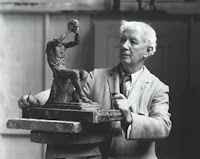 |
| Michelangelo Buonarroti, 1635, Jacopino del Conte |
 |
| Gian Lorenzo Bernini Self-portrait, 1635 |
There are two ways of studying art and artists of the past. One is to isolate a single artist of renown for in-depth study (indeed, often just a single work). The second is to study an artist in the context of his peers from the same era or broader period. For example, we can study Picasso and his 92 years of output, or we can study Picasso as compared to Matisse and the period in art history in which both men lived and worked. Often it's difficult to align an outstanding artist with a peer from the same era simply because that artist literally had no equal (as the term "peer" would suggest). That would, for instance, be the case with Michelangelo Buonarroti. There were painters who matched his skill, architects who were his equal, even sculptors who perhaps came close, but no man who combined all these skills into a single body of work. Thus it's necessary to go shopping for such an artistic genius in neighboring eras. In Michelangelo's case we must skip the troubled wasteland of the Mannerist era following the Renaissance to the much richer vein of Baroque art starting around 1600 and in particular that of Gian Lorenzo Bernini.
 |
| Madonna of the Stairs, 1491, Michelangelo |
 |
| Rondanini Pieta, 1564, Michelangelo |
Michelangelo died in 1564. Bernini wasn't born until 1598, a whole generation later. Times change. Art changed. The liberal humanism of the Renaissance gave way to the tight-laced conservatism of the Counter-Reformation. Michelangelo endured the early years of this movement. Bernini was shaped entirely by the later years. Thus the comparison is not perfect. However Bernini stands up well against the Renaissance demi-god of sculpture who obviously influence him, and whom he perhaps idolized. From his teenaged Madonna of the Stairs (above, left) to his touching (and unfinished) Rondanini Pieta (above, right), which he worked on the last twelve years of his life, Michelangelo sculpted some forty-three pieces. Bernini created around sixty over a lifetime that was some seven years shorter (at 82) than Michelangelo's (89 years). Bernini's architectural works also far outnumber those of Michelangelo. However, though Bernini could knock out a "dead-on" portrait in oils (or marble), he in no way approached Michelangelo's legendary painting skills. Michelangelo insisted, but later inadvertently disproved, painting was "not his art." Bernini would have undoubtedly made the same claim.
 |
| Bernini's David in action, 1623-24 |
 |
| The Ecstasy of St. Theresa (detail) 1647-52 Gian Lorenzo Bernini |
For a lengthy video of Bernini's work, click here.
 |
| Apollo and Daphne (detail), 1622-25, Gian Lorenzo Bernini |









































;_Zoffany,_Johann.jpg)




